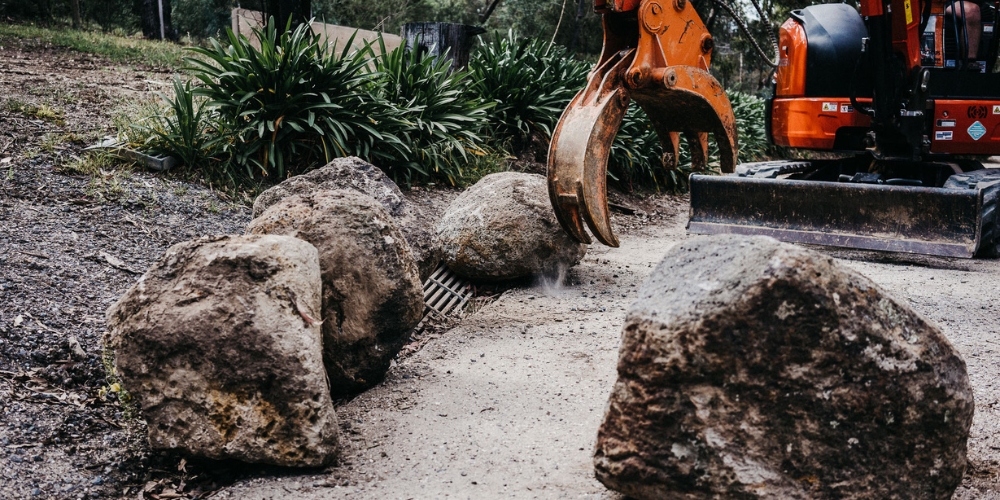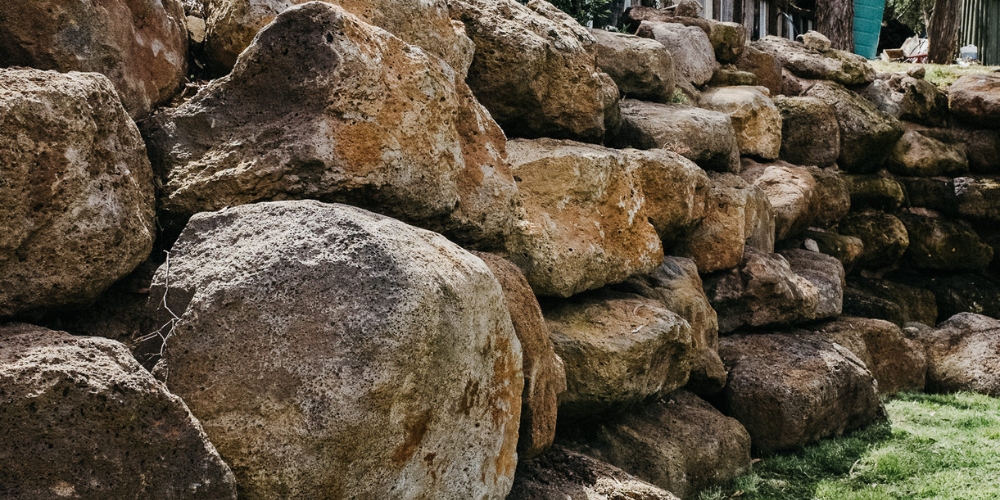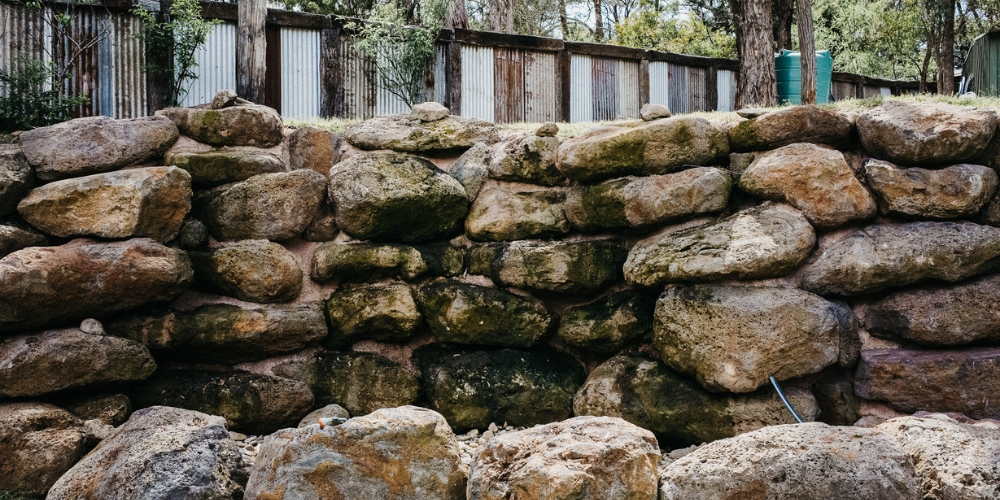Building A Large Rock Retaining Wall
A large rock retaining wall creates a barrier with carefully placed rocks or boulders to keep a soil bank in place. If your yard is uneven, a boulder retaining wall may prevent erosion and provide a beautiful plant area. If you want a rustic, natural look, a large rock retaining wall should be at the top of your list.
Rocks are highly robust and resistant to weathering and erosion, and their sheer weight enables them to hold enormous quantities of soil in place. On the other hand, a rock retaining wall must be built correctly to avoid collapsing or eroding.
Retaining walls, apart from preventing soil erosion, provide aesthetic focus points in the landscape and improve the slope of steeps, among other things. Hilly areas have a significant effect on problems with rock retaining walls. Slopes are transformed into valuable garden areas by retaining walls built to exacting standards.
Rock retaining walls are used to assist the transition from one ground level to the next. A large rock retaining wall improves flat, usable land by cutting through a slope and allowing for smooth ground above and below the boulder retaining wall. As long as the wall isn’t higher than 3 feet, building a big rock retaining wall is doable.

What is a rock retaining wall, and how does it work?
Using carefully placed rocks or boulders to form a barrier to keep a bank of soil in place, this type of garden retaining wall is quite popular.
Even if a more miniature replica of the structure is being built in your backyard, it is not necessarily a random pile of rocks in your yard. In this situation, it will be necessary to strengthen or reinforce the footing of the wall to prevent water from destroying the whole construction.
According to the manufacturer’s specifications, individual rocks or boulders retaining walls will be carefully selected and placed one at a time by retaining wall builders experienced in this type of wall to guarantee optimum longevity for the whole construction.
Rock retaining walls are made of a variety of materials, including sandstone and bush rock. Bluestone porphyry rock is a kind of rock composed of bluestone and porphyry. In addition to helping to break up a boulder retaining wall visually, strategically planted plants may also assist in minimizing soil erosion through it.
Building A Large Boulder Retaining Wall: Rules And Policies
Obtain a copy of your city’s building code and zoning laws before beginning construction on a boulder retaining wall to see if any applicable rules and legislation govern retaining walls. A wall higher than 3 feet in height will need an engineer’s stamp in most cases. However, a wall higher than 30 inches in height will not be permitted in some areas. Finally, if your city requires retaining walls to be built higher than a certain height, you will be required to get permission and undergo an inspection before proceeding. Before building starts, make sure there are no potential risks.
Which Is Better: Mortared or Stacked Rock Retaining Walls?
The mortar used to construct wet-laid and dry large natural stone retaining walls is the most important distinction. The beautiful rocks are held together by mortar, which is used to build the wet wall. Because it is kept together by a combination of gravity, good craftsmanship in the form of fitting stones together in an interlocking pattern, and a natural gravel base to keep the rocks from moving, a stacked rock retaining wall design does not need the use of mortar.
When done properly, stone stacking binds the stones together and creates the wall. The workmanship would also be determined by constructing a stream rock retaining wall to guarantee that excess surface water is channeled down the creek beds via an appropriate exit or collecting point.
On the other hand, a wet stone wall is built on a solid concrete base with mortar put to the wall and requires extra drainage and supplies that are not needed when building large natural stone retaining walls. The mortared wall will be the expensive of the two choices due to the use of mortar and the additional labor needed.
Because it is not reliant on mortar, a well-built dry rock retaining wall will outlast a properly constructed mortared wall. It will not disintegrate as the mortar wears away as all mortar does eventually. It may flex somewhat, moving with the ground underneath it instead of separating like a stiff, mortared wall.
Cost Of Building A Large Rock Stone Retaining Wall
The following factors will influence the price of your boulder wall construction:
- The length, height and width of the retaining wall
- Design, including excavation and drainage concerns, and the kind of retaining wall rocks you use
- Whether you construct it yourself or pay someone to do it for you,
Large rock retaining wall constructions might cost tens of thousands of dollars. If your rock retaining wall requires council permission and structural schematics, expect to spend extra since you’ll be responsible for these additional expenses.
Expect to be priced based on materials and labor, with materials being estimated per square meter. The cost of rocks or boulders retaining wall is expected to be:
For unselected rock, the cost ranges from $140 to $250 per square meter.
For higher grade carved boulder stone, the price range will be $180 to $280 per square meter.
A grade cut sandstone costs between $280 and $500 per square meter.
A hand-placed boulder or rock retaining wall has a rustic appearance, but it has more definition than a carelessly put version.
Who Can Build A Large Rock Retaining Wall?
In most areas of Australia, you can build a small or low rock retaining wall yourself, but more enormous retaining walls will almost always need to be planned and constructed by professional retaining wall installers.
Retaining wall contractors must be licensed in most regions. This may be a builder, landscaper, bricklayer, or stonemason, depending on where you reside.
For the design of your retaining wall, you may need to contact a structural engineer. Check with your retaining wall builder or the local government to find out what applies where you reside.
Constructing a Durable Rock Retaining Wall
Flat rocks for retaining walls need careful planning and, in certain instances, skilled engineering to keep their shape. Theoretically, a big rock retaining wall of 3-4 feet in height and 15 feet long could withstand 20 tonnes of soil pressure. Unstable walls that bulge or fall entirely may result from poor construction design. So, retaining walls above three feet high should be designed and constructed by experts.
DIYers may construct smaller retaining walls with basic building skills. If you want to get your hands dirty and enhance your landscape by building a retaining wall, following the proper set of guidelines can help. The enormous natural stone retaining walls are like a vast three-dimensional puzzle. The rocks are heavy, so take caution.
It’s appealing to construct a retaining wall from flat rocks, knowing that it will stand the test of time. Terraces and raised garden beds may be built using old techniques like dry rock retaining walls. These tried-and-true methods also guarantee how to build a creek rock retaining wall.

How To Build A Rock Retaining Wall
Large rock retaining walls blend into any landscape, especially the mud rock retaining walls. These rocks come in various shades of earthy brown and are incredibly versatile and can be split easily into large plates that make it a choice for constructing retaining walls.
Backfill soil is naturally held back by boulders. The heavier the boulders, the more stability it provides to the wall; larger ones are preferable, particularly at the foundation. Rock walls are both attractive and functional as retaining walls.
Before commencing to build a rock retaining wall, make sure to assemble the following materials for smooth completion of the task:
- Level Line level and string or garden hose
- Shovel
- Mason’s hammer
- Stakes
- Carpenter’s level and string or hose
Let’s get started with a step-by-step guide to learning how to build a rock retaining wall:
Calculate the Height/Base Thickness Ratio
Make a strategy for the wall’s location. How high do you want it? The base should have the same thickness as the height. A wall over five feet high may maintain a thickness of 4–5 feet with attention to the placement of the stones in the rear.
However, if you’re constructing an 8–12 foot high wall, you’ll want to raise the base thickness to six or seven feet and maintain it there until you’ve reached half the wall’s height. Then start tapering towards the face, finishing with a 2–3 foot breadth at the summit. The top of your wall should be about this width—or somewhat less if you wish to plant.
Remember that the first location you see your retaining wall may not be the sole option. Moving a wall away from a bank may save material. You may construct a shorter retaining wall with the same slope or extend the wall farther for a more gradual slope. Fill up the space with additional soil/gravel.
Most DIYers can handle walls three feet high or less. Professionals may be needed for higher walls to guarantee proper construction. Depending on where you reside, you may additionally require municipal permission for walls above three feet tall.
Slope the Back Wall
Plan to dig out the foundation and place the stones such that they slope towards the rear of the wall—at least a two-inch drop for every foot of height.
Draw a Wall Cross Section
A side view of your wall should show a triangle. The triangle’s size should be at least equal to, if not larger than, the space behind it from the base up. The weight of the stones and the inward slope will help your wall resist the backfill pressure.
A Second Tier Requires More Work
If you want to construct a second layer, you need to determine where your wall faces and backing will go and how the weight of the higher wall will be transferred to the space below it.
For example, a four-foot front wall with a three-foot rear wall will cause the front wall to bend inward and ultimately collapse. The top wall distributes its weight across the space below at a 45-degree angle.

Getting the Wall's Base Ready
Construct The Foundation
Beginning at the string and moving back toward the slope, remove all the soil from the area. Dig down 12 inches into the ground to create a flat, level trench 12 inches wide and 12 inches deep for the gravel foundation and first block course. Dig into the slope to create a 6-12-inch gap between the backside of the wall and the slope, which will be used to store drainage stones. Take measurements down from the level line as you dig to make sure the excavation is level.
Lay The First Course
Lay the first row of rocks on top of the landscaping fabric. Create the second row of boulders by lining the dirt wall with landscaping fabric. Landscape fabric comes in various thicknesses and weights. Even the lightest fabric would provide 25 years of protection and may be found at the hardware store. You may buy thicker boulder retaining wall material from a nursery or a landscaping supply store.
Make sure the rocks are in the right place.
The following three stages are performed frequently to build a boulder retaining wall:
Create the first course, backfill with the subsoil removed when the slope was cut back, and compress the backfill using a rake or other tool.
Then it’s time to move on to the next course.
Arrange Boulders of Appropriate Size
The stones must be the appropriate size to the size of the wall for both strength and aesthetic appeal. To fit correctly, use a range of rocks in sizes ranging from large to medium. Use natural boulders such as granite, limestone, or other natural stones to construct large natural stone retaining walls. Sort the rocks in order of size, beginning with the largest and start by placing the bottom row of rocks on top of the fabric and ensuring that they are in contact. Before returning to the second row, place six to eight of the big stones down. If the stones are not firmly packed against the earth wall, pull the cloth forward and fill behind them.
Follow The Rows' Contour
The second row of boulders should follow the curvature of the previous row, with the boulders pushing back on the dirt wall. With the landscape fabric placed behind each rock, the second row should be positioned such that the boulders fit on top of the junction where the bottom two boulder rocks connect. Some boulders may be positioned vertically to provide interest and aesthetics to your retaining wall. This may take up two rows, depending on the size of the boulder, but it may be worked around to create a pleasant aesthetic effect. Repeat the bottom row and second row to accomplish the lock-in style for the retaining wall’s foundation. The procedure may then be repeated for each subsequent layer.
Install Additional Courses
Install the long stones that reach back into the slope to help tie the wall into the earth, starting with the third course, using the same techniques as the previous courses.
Filling in the Blanks
Small rocks should be used to fill up significant gaps between boulders—roll landscaping fabric over the top of the dirt to complete the top of the boulder wall. If not, cut the fabric back and use a lighter to seal the edges. Backfilling the wall with rock improves drainage and prevents dirt from penetrating the stone fractures in the wall.
Vital Work Tips
It’s like putting together a puzzle when you’re constructing a retaining wall. To begin, place the rocks in a jigsaw puzzle-like pattern.
- As capstones, set aside your best, broadest, flattest rocks. Place capstones on top of the foundation and check the height.
- Place capstones one by one, inspecting them along the way. The capstones should raise the wall to about the same level as the dam. Then, behind the capstones, reattach the cloth and add soil.
- Use your most giant rocks for the first course. As a result, you won’t have to raise them. Use a wood board to wrap up any remaining large rocks after the first course.
- Fitting boulders together is mostly trial and error. By initially analyzing the pier, you may reduce its size and shape. Then go on a fitness search. You can even use a tape measure. It’s not fun to cut through rocks. It’s also challenging to get it right. To pull troublesome knobs off, use a hammer and a cold chisel if required. If necessary, a hammer and a cold chisel may be used to pry hard knobs off.
Avoid The Commonly Committed Mistakes
- Installing a drainage tile behind your wall without first preparing the drain. If even the slightest shift takes place, water will gather and move your wall.
- Burying your foundation stones underneath the completed landscape terrain’s future layers. Water will collect around and under the base stones as a result of this.
The Final Word
Large rock retaining walls are essential for assisting with the transition from one ground level to another as well as increasing the value of usable flat land by making it more appealing. It boosts the value of usable flat land by making it more appealing. On the other hand, professionals must build retaining walls correctly to endure a long time and be visually pleasing.
Whether you are in Bulleen or Fairfield, you can always find retaining wall contractors to guide you along the project.
